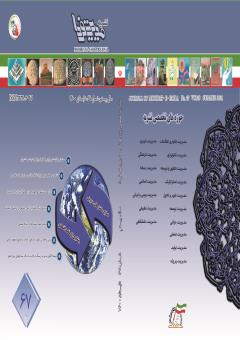-
-
List of Articles
-
Open Access Article
1 - Designing organizational structure in accordance with the functional activities of the mosque
Morteza Rojouei seyyed morteza ghayour mostafa sanati hajjar -
Open Access Article
2 - Identifying components of performance management system to develop administrative integrity
Ali Asghar Pourezzat hossein imani aryan gholipour Adel Azar -
Open Access Article
3 - Designing and Explaining Marketing and Sales Strategies Model in the Food Distribution Industry
mahdi haghighi kafash zohre dehdashtishahrokh vahid khashee var nam khasti reza hajari -
Open Access Article
4 - Authoritarian Leadership and Decrease in Protein Talent: An Analysis of the Mediating Role of Bureaucratic Culture (Case Study: State-Owned Pharmaceutical Companies)
reza sepahvand Mohammad hakkak masood sepahvand fariborz fathichegini -
Open Access Article
5 - Identification and analysis of the service capabilities in Iran’s small enterprises (SEs) using integrated interpretive structural modeling and fuzzy MICMAC approach
davod khosroanjom Ali Rajabzadeh Ghatary عباس مقبل -
Open Access Article
6 - Organizational Strategic Fitness of Sepah Bank: A Study in Branches of Shiraz city
Jafar Torkzadeh Kobra Pour Karim somayeh mezginezhad -
Open Access Article
7 - The Effect of Developing Countries’ E-readiness Inicators On Corruption
Mohammad fathian یاسر سبحانی فرد Hamid Kazemloo -
Open Access Article
8 - analytical - rational explanation (definition, concept, history, differentiation, similarity, propagation and expansion) of free innovation
Ali Asghar Saadabadi Mohammad Sadegh khayyatian فاطمه محمدی اترگله -
Open Access Article
9 - Presentation of IoT Policies Pattern in Iran through Applying of Thematic Analysis Method
Leyla Hasanzadeh Garavand Mahdi Abdolhamid Amir Zakery -
Open Access Article
10 - Future Proofing Model of the Sustainable Water Resource Management based on the Scenario Planning Approach- Case Study: Golestan Province
Seyed Mansour Rahim Hoseini Aliakbar Hasani -
Open Access Article
11 - Analysis of Service Supply Chain Anti-fragility in Iran Insurance Industry
Sayyed Maisam Momeni ahmadreza ghasemi meysam shahbazi Amir Safari -
Open Access Article
12 - Identification and Prioritization of Service Outsourcing Factors (Case Study: General Department of Roads and Urban Development of Mazandaran)
ramzan gholami Milad Gholami Mojtaba Tabari -
Open Access Article
13 - The effect of professional ethics model of higher education managers on improving their efficiency
Ameneh Rabiee عصمت مسعودی amineh ahmadi -
Open Access Article
14 - Investigating the Factors Affecting the Performance Evaluation of Social Security Brokers in Isfahan Province
seyedalireza ebrahimi seyedhamid Ghoreishi -
Open Access Article
15 - Designing the maturity model of knowledge management in cultural organizations ) Case study Art and Cultural Organization of Tehran Municipality(
Ali Ali Mohammadi, Younos Vakil Alroaia Ismail Kavossi BAHRAM alishiri Alireza Ebrahimpour -
Open Access Article
16 - A performance-based State Universities of Iran: a qualitative study of requirements and barriers of performance-based funding According to principal-agent theory
zargham faramarzi nia حمید فرهادی راد Yadollah Mehralizadeh Rahamatolah Gholipor sute -
Open Access Article
17 - Identifying key indicators affecting the quality of decision-making in business intelligence systems by delphi method and dematel technique
Payam Yaghli Tahmores Sohrabi سید علیرضا درخشان -
Open Access Article
18 - Meta Analysis Of Soft Operations Research Methodology In Governance Studies
Alireaza Aliahmadi mehdi ghazanfari gholamreza salimi hosein mohammadi Mohammadbagher Aali
-
The rights to this website are owned by the Raimag Press Management System.
Copyright © 2017-2026







